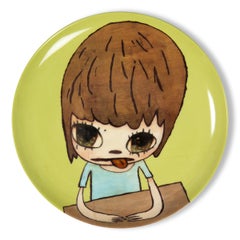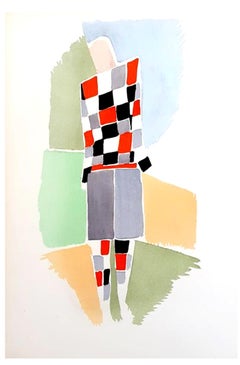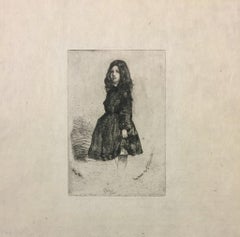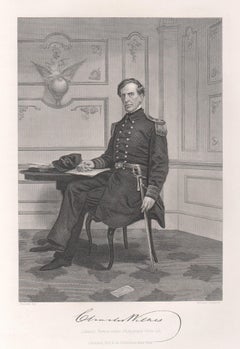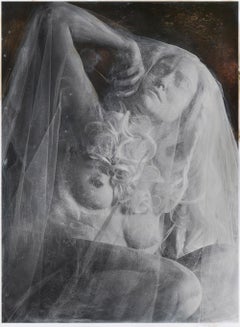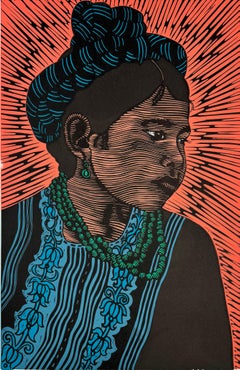Miniature Portrait Prints
to
826
3,580
1,523
1,707
1,068
757
Overall Width
to
Overall Height
to
1,567
393
309
135
73
69
60
54
32
31
13
8
4
3
267
87
79
51
49
214
1,332
1,633
401
37
70
114
110
110
127
180
209
82
71
167
2,841
589
132
2,781
1,461
1,280
1,227
1,074
726
672
377
368
315
228
138
103
87
80
76
74
64
59
56
1,397
1,206
513
287
217
255
1,873
1,520
1,216
Size: Miniature
Yoshitomo Nara, Girl in the Moon - Limited Edition Plate, Japanese Art
Located in Hamburg, DE
Yoshitomo Nara (Japanese, born 1959)
Girl in the Moon, 2022
Medium: Porcelain plate (fine bone china)
Dimensions: 10 1/2 in diameter 26.7 cm diameter
Edition of 250: Printed signatu...
Category
21st Century and Contemporary Pop Art Figurative Prints
Materials
Porcelain
27 Living Paintings - Colour Pochoir
Located in Collonge Bellerive, Geneve, CH
Full-page, colour pochoir of costume designs after Sonia Delaunay's watercolors
Edition 331/500 copies on Velin Aussedat
Dimensions: 28.5 x 19.5 cm.
From 27 Living Paintings. [Milano, Edizioni del Naviglio, 1969]. Jacques Damase. Robes Poèmes, Introduction. Text by Guillaume Apollinaire and Blaise Cendrars.
Sonia Delaunay was known for her vivid use of color and her bold, abstract patterns, breaking down traditional distinctions between the fine and applied arts as an artist, designer and printmaker.
Born Sarah Stern on November 14, 1885 in Gradizhsk, Ukraine, she was adopted in 1890 by her maternal uncle, Henri Terk, a lawyer in St. Petersburg, where she grew up, exposed to music and art, and learning several foreign languages. In 1903, she moved to Germany to study drawing with Ludwig Schmidt-Reutler (1863–1909) at the Karlsruhe academy of fine arts; Arnold Schoenberg (1874–1951), composer-to-be, was among her classmates there. In 1905, she traveled to Paris where she attended art classes at the Académie de la Palette, learned printmaking from Rudolf Grossman (1889–1941), and met Amédée Ozenfant (1886–1966), André Dunoyer de Segonzac (1884–1974), and Jean-Louis Boussingault (1883–1943). Sonia spent much of her time at exhibitions and galleries in Paris, which showed works by Paul Cézanne, Vincent Van Gogh, Pierre Bonnard, and Edouard Vuillard, as well as Les Fauves, Henri Matisse and André Derain. She did, however, maintain contact with Germany, exhibiting at the Galerie Der Sturm, Berlin, in 1913, 1920 and 1921.
During her first year in Paris, Sonia met the German collector and art-dealer, Wilhelm Uhde (1874–1947), whom she married on December 5, 1908, and whose Montparnasse gallery, the Galerie Notre-Dame des Champs, showed her first solo exhibition. Through Uhde, Sonia encountered many painters, including Pablo Picasso, Georges Braque, Maurice de Vlaminck, and Robert Delaunay (1885–1941). In 1910, Sonia divorced Uhde by mutual agreement, married Delaunay that same year, and gave birth to their son, Charles, in January 1911.
Together Sonia and Robert Delaunay pursued the study of color, influenced by theories of Michel-Eugène Chevreul (1786–1889). Sonia’s interest in simultaneous contrast, as evidenced in her early collages, book bindings, small painted boxes...
Category
1960s Abstract Geometric Portrait Prints
Annie - Etching by James Whistler
Located in Roma, IT
Signed 'Whistler' lower left, titled 'Annie', center, and annotated 'Imp. Delâtre Rue St. Jacques. 171' in the plate lower right.
From the portfolio: "Douze Eaux-Fortes d'après Natur...
Category
1850s Post-Impressionist Portrait Prints
Materials
Etching
Charles Wilkes, 19th century American US naval explorer portrait engraving print
Located in Melbourne, Victoria
'Charles Wilkes'
Steel-engraving after Alonzo Chappel's sketch after a photograph. 1864. Facsimile signature under the engraving.
Charles Wilkes (1798 - 1877) was an American naval...
Category
Mid-19th Century Naturalistic Portrait Prints
Materials
Engraving
Hand coloured framed print of semi nude sculpture like marble statue of female
Located in London, GB
Katie Eleanor, "Cleansing a Shrike (Blackbird’s Birdbath)", 2018
Handcoloured portrait of a bird-like spirit, immobilised in marble, cleansing in a sprin...
Category
2010s Romantic Portrait Prints
Materials
Glass, Oak, Paint, Watercolor, Photographic Paper, Archival Pigment
Teracita, by Juan Fuentes
By Juan Fuentes
Located in Palm Springs, CA
Medium: linocut
Year: 2016
Image Size: 18 x 12 inches
Edition Size: 20
Young girl in indigenous dress and jewelry.
As a cultural activist/artist/printmaker, Juan Fuentes has dedicated his career to being part of a global movement for social change. His works address issues relating to local communities of color, social justice, and international struggles for liberation.
Fuentes' relief printing process follows closely the social realist tradition of Latin American artists such as Jose Guadalupe...
Category
2010s Contemporary Portrait Prints
Materials
Linocut
SELF PORTRAIT DRAWING
Located in Santa Monica, CA
MAX LIEBERMANN (1847 1935)
SELF PORTRAIT DRAWING (Selbstportrat) c. 1922 (Schiefler, 341, III b)
Etching, signed in pencil, Scarce signed example found in Max Liebermann “Sein Leb...
Category
1920s Impressionist Portrait Prints
Materials
Etching
Sir Lawrence Alma-Tadema, Pre-Raphaelite, portrait etching by Paul Adolphe Rajon
Located in Melbourne, Victoria
Rajon began his career as a photographer while studying at Ecole des Beaux-Arts Paris. This original etching of Alma Tadema was etched by Rajon on one of h...
Category
Late 19th Century Naturalistic Portrait Prints
Materials
Etching
"Auguste Pellerin" lithograph
Located in Henderson, NV
Medium: lithograph (after the painting). Printed in Paris on smooth wove paper at the atelier Mourlot and published in 1954. Size: 10 x 6 1/2 inches (257 x 163 mm). Not signed.
Con...
Category
1950s Portrait Prints
Materials
Lithograph
Musician - Original Etching by Carlo Alberto Trilussa - Early 20th Century
Located in Roma, IT
Musician is an original etching print on ivory-colored paper realized by Carlo Alberto Trilussa.
Hand-signed on the lower right in pencil, it is a rare Hand-signed edition.
Good con...
Category
Early 20th Century Modern Portrait Prints
Materials
Etching
"Prelato di Mantelletta" - Etching by Giuseppe Capparoni - 1828
Located in Roma, IT
"Prelato di Mantelletta" is an Artwork realized in 1828 by the Engraver, Giuseppe Capparoni (Rome 1800- 1879).
Etching hand colored on ivory paper. Signed on plate on the right marg...
Category
1820s Modern Portrait Prints
Materials
Etching
Po-Ca-Hon-Tas: Original Hand-colored McKenney & Hall Lithograph
Located in Alamo, CA
This is an original 19th century hand-colored McKenney and Hall lithograph of a Native American entitled "Po-Ca-Hon-Tas", lithographed by J. T. Bowen after a painting by Charles Bird...
Category
Mid-19th Century Naturalistic Portrait Prints
Materials
Lithograph
$540 Sale Price
20% Off
The Consistorial Lawyers - Etching by Giuseppe Capparoni - 1828
Located in Roma, IT
The Consistorial Lawyers is an Artwork realized in 1828 by the Engraver, Giuseppe Capparoni (Rome 1800- 1879).
Etching hand colored on ivory paper. Signed on plate and dated on the ...
Category
1820s Modern Portrait Prints
Materials
Etching
Devil /// Contemporary Pop Art Minimalism Linocut Black and White Art Religious
By Dan May
Located in Saint Augustine, FL
Artist: Dan May (American, 1955-)
Title: "Devil"
*Signed and numbered by May in pencil lower left
Year: 1999
Medium: Original Linocut on white Hosho handmade paper
Limited edition: 1...
Category
1990s Contemporary Portrait Prints
Materials
Handmade Paper, Linocut
"Femme assise sur un canapé" original etching
Located in Henderson, NV
Medium: original etching with drypoint. Catalogue reference: Fiorani 23. This impression on laid paper was printed in 1913 and published by Gazette des Beaux Arts. The image size is ...
Category
1910s Portrait Prints
Materials
Etching
Untitled
Located in Barcelona, BARCELONA
Includes a Certificate of Authenticity
Category
1990s Abstract Geometric Portrait Prints
Materials
Engraving
lithograph for Florilege des amours de Ronsard
Located in Henderson, NV
Medium: lithograph (after Matisse). Printed in sanguine ink on cream laid paper from the Papeteries Casteljoux and published in Geneva by Edito-Service in 1970. This reproduces one o...
Category
1970s Portrait Prints
Materials
Lithograph
Ballet
Located in Middletown, NY
Etching on heavy white wove paper, 12 x 17 1/2 inches (305 x 445 mm); sheet 19 1/2 x 25 inches (508 x 635 mm), full margins. Signed, dated, and numbered 7/50 in orange crayon, and ti...
Category
Mid-20th Century Modern Figurative Prints
Materials
Etching
The Hypochondriac - Original Lithograph and Offset by George Grosz - 1923
By George Grosz
Located in Roma, IT
The Hypochondriac is an original offset and lithograph print realized by George Grosz.
The artwork is the plate n.21 from the portfolio Ecce Homo published between 1922/1923, editio...
Category
1920s Expressionist Portrait Prints
Materials
Lithograph, Offset
Mao from New York Collection for Stockholm (F&S II. 89), Lt Ed Unique variation
By Andy Warhol
Located in New York, NY
Andy Warhol
Mao. from the New York Collection for Stockholm (F&S II. 89), 1973
Sequential Xerox Print on Typewriter Paper
Hand signed in ink and numbered 25/300 by Andy Warhol (uniqu...
Category
1970s Pop Art Portrait Prints
Materials
Paper, Ink
$24,000 Sale Price
40% Off
Art Card: Wrapped Portrait of Jeanne-Claude, 1963 (Hand Signed by Christo)
Located in New York, NY
Christo and Jeanne-Claude
Wrapped Portrait of Jeanne-Claude, 1963 (Hand Signed), 1988
Offset lithograph postcard
Boldly signed by Christo on blue crayon
Provenance: Gifted by the art...
Category
1960s Pop Art Portrait Prints
Materials
Postcard
Sir John Ross, Arctic Explorer, 19th century portrait engraving print
Located in Melbourne, Victoria
'Sir John Ross'
Steel-engraving. C1850.
220mm by 130mm (sheet)
Sir John Ross (1777-1856) became an Arctic explorer after distinguished naval service in the Napoleonic Wars. In 18...
Category
Mid-19th Century Naturalistic Portrait Prints
Materials
Engraving
Femme à l'écharpe rouge. " Exemplaire d'Auteur "
By Jean Cocteau
Located in CANNES, FR
Jean Cocteau ( 1889-1963 )
" Femme à l'écharpe rouge "
Exemplaire d'Auteur .
hand signed Jean Cocteau .
Partially glazed white earthenware plate with engobe
conceived in 1958 In an ...
Category
1950s Surrealist Portrait Prints
Materials
Ceramic
$11,361 Sale Price
20% Off
My Hand Shook
Located in Saint Petersburg, FL
Offered at an exceptional price, this piece is in excellent condition and will ship rolled. Edition number 49 / 200.
There are 200 pieces in the edition all signed and numbered by...
Category
1970s American Realist Portrait Prints
Materials
Lithograph
Carmen, The Expression - Original Etching (Cramer #52)
Located in Paris, IDF
Pablo PICASSO
Carmen, The Round Face, 1949
Original burin engraving (Atelier Lacourière, Paris)
Unsigned
On Montval wove paper 33 x 26 cm (12.9 x 10.2 in)
REFERENCES :
- Catalog r...
Category
1940s Modern Portrait Prints
Materials
Etching
YOU ARE HERE, Giclée Print, Pop-Art, Small Limited Edition, Signed by the Artist
Located in Palm Desert, CA
YOU ARE HERE by Ramona Nordal, 2022
Size: Image 12 x 16 inches, Paper 14 x 18 inches
Giclee Print on Hahnemühle Photo Bright White Rag
Numbered (2/5) and signed by the artist
COA (Ce...
Category
2010s Pop Art Portrait Prints
Materials
Giclée
lithograph for Florilege des amours de Ronsard
Located in Henderson, NV
Medium: lithograph (after Matisse). Printed in sanguine ink on cream laid paper from the Papeteries Casteljoux and published in Geneva by Edito-Service in 1970. This reproduces one o...
Category
1970s Portrait Prints
Materials
Lithograph
Cypriano (A Basque Boy)
Located in Middletown, NY
Etching on cream wove paper. 6 5/16 x 3 3/4 inches (159 x 94 mm), full margin. Signed in pencil lower center margin, from the edition of 111. A well inked impression with a minor cre...
Category
Mid-20th Century American Modern Portrait Prints
Materials
Handmade Paper, Etching
Waiting room at the Admiralty (*no Misnomer)
Located in Middletown, NY
London: Thomas McLean, 1820. Second Edition. Etching with handcoloring in watercolor on cream wove paper (published 1835), 8 3/8 x 11 1/2 inches (210 x 29 0mm), full margins. Second...
Category
Early 19th Century Victorian Figurative Prints
Materials
Etching, Watercolor
Portrait of a girl writing on a slate.
By Oszkar Glatz
Located in Middletown, NY
Etching with extensive hand coloring in watercolor on white wove paper, 13 3/4 x 10 3/4 inches (347 x 271 mm); sheet 24 x 17 inches (608 x 430 mm), full margins. In good condition wi...
Category
Early 20th Century Modern Figurative Prints
Materials
Watercolor, Etching
James Basire after Guercino - Framed 18th Century Etching, Study of Janus
Located in Corsham, GB
Original etching. 'Janus' the Roman Two-Faced God of Duality Beginnings and Endings. Signed in plate. Well presented in a white card mount and gilt-effect frame. On paper.
Category
Early 18th Century Portrait Prints
Materials
Etching
Portrait of Baron Simolin II (large version)
By Max Beckmann
Located in Roma, RM
Max Beckmann (Leipzig 1884 – New York 1950), Portrait of Baron Simolin II (large version)(1928)
Drypoint, 38 x 25 cm (plate), 48 x 40 cm (sheet), signed and dated lower right.
Category
1920s Expressionist Portrait Prints
Materials
Drypoint
"Alfred Stevens" original etching and drypoint on japon paper
Located in Henderson, NV
Medium: original etching and drypoint. This is an earlier-state proof before letters were added for the final published edition. Printed in 1900 for Gazette des Beaux-Arts. Plate siz...
Category
Early 1900s Portrait Prints
Materials
Etching
" La Mystérieuse Dame Grise" . Mystery Woman
By Jean Cocteau
Located in CANNES, FR
" La mystérieuse dame grise " . Jean Cocteau Edited in 1963 .
terracotta partially glazed . edition originale .
signed Jean Cocteau / atelier Madelin...
Category
1960s Modern Portrait Prints
Materials
Ceramic
Floral Portrait with Red Hat and Bow on Black Background. Limited Edition Dibond
Located in FISTERRA, ES
"Floral Portrait with Red Hat and Bow on Black Background" is a limited edition high-quality Dibond direct UV Print titled "The Pioneer of the School No. 39". This piece, like the en...
Category
2010s Contemporary Portrait Prints
Materials
Metal
Emma Malietoa, 19th century Samoa portrait engraving print
Located in Melbourne, Victoria
'Emma Malietoa'
Portrait of Samoan woman Emma Malietoa, daughter of Chief Malietoa, of Apia, Upolu Island, Samoa.
From Narrative of the United States Exploring Expedition ... / Cha...
Category
Mid-19th Century Naturalistic Portrait Prints
Materials
Engraving
Oval Portrait by Ludovic-Rodo Pissarro - Wood engraving
Located in London, GB
Oval Portrait by Ludovic-Rodo Pissarro (1878 - 1952)
Woodcut
15.1 x 11.3 cm (6 x 4¹/₂ inches)
Initialled, inscribed and dated 1918 in the plate
Signed lower right, Ludovic Rodo and n...
Category
1910s Post-Impressionist Portrait Prints
Materials
Woodcut
Kish-Ke-Kosh, Fox Brave: Original Hand-colored McKenney & Hall Lithograph
Located in Alamo, CA
This is an original 19th century hand-colored McKenney and Hall lithograph of a Native American entitled "Kish-Ke-Kosh, Fox Brave", lithographed by J. T. Bowen after a painting by Charles Bird King and published by Rice and Hart & Co. in Philadelphia in 1848. Kish-Ke-Kosh, means 'The Man with One Leg' or 'He with a Cut Hoof'. He had a reputation for being a fierce warrior. He was a representative of the delegation of Sioux and Fox and Sauk chiefs who attended the gathering with the War Department in 1837. The Fox tribe lived in the Great Lakes region of the United States and merged with the Sauk tribe.
This original McKenney and Hall hand-colored lithograph is printed on a sheet measuring 10.38" high and 7" wide. There are tiny spots in the lower left margin, another in the right lower margin and mild smudging in the left margin, but the print is otherwise in very good condition. The original descriptive text pages, 119-120, from McKenney and Hall's 19th century publication are included.
Col. Thomas J. McKenney was Superintendant of The Bureau of Indian Affairs from 1816 until 1830. He was one of a very few government officials to defend American Indian interests and attempt to preserve their culture. He travelled to Indian lands meeting the Native American leaders. He brought with him an accomplished artist, James Otto Lewis...
Category
Mid-19th Century Naturalistic Portrait Prints
Materials
Lithograph
"Sculpture of Matisse" lithograph poster
Located in Henderson, NV
Medium: lithograph (after the original lithograph poster for the Tate Gallery Matisse sculpture show). During the late 1940's and throughout the 1950's, Henri Matisse created a serie...
Category
1950s Portrait Prints
Materials
Lithograph
Vieille Masken, La Servante Anversoise
Located in Middletown, NY
Etching with engraving and drypoint printed in brownish black ink on cream laid paper with a partial heraldic A and fleur-de-lis watermark, 5 5/8 x 4 1/4 inches ( 341 x 107 mm), full...
Category
Late 19th Century French School Portrait Prints
Materials
Laid Paper, Engraving, Drypoint, Etching
Maenad in Frenzy, British Museum Roman Classical sculpture photogravure
Located in Melbourne, Victoria
'Maenad in Frenzy'
Photogravure from a collection of photogravures depicting Greek and Roman marbles and bronzes in the British museum. Plate number above top right corner of the im...
Category
1910s Other Art Style Portrait Prints
Materials
Photogravure
"Buste d'enfant, tourné à droite" original etching
Located in Henderson, NV
Medium: original soft ground etching. This is a lifetime impression printed in 1914 on laid paper and published in Berlin by Bruno Cassirer for Theodore Duret's "Die Impressionisten"...
Category
1910s Impressionist Portrait Prints
Materials
Etching
Utagawa Kunisada(Toyokuni III) -- A Woman Diver Combing Her Hair 美人合 春曙
Located in BRUCE, ACT
Utagawa Kunisada (Toyokuni III)
Diving Woman Combing Her Hair, 「美人合 春曙」髪をとく美人
from the series Spring Dawn: A Contest of Beauties (Haru no akebono...
Category
1820s Portrait Prints
Materials
Woodcut
Andy Warhol Portraits of Jews of the 20th Century (announcements)
Located in NEW YORK, NY
Andy Warhol "Ten Portraits of Jews of the Twentieth Century": A complete set of ten Warhol announcement cards published in conjunction with Andy Warhol's 1980 exhibition at The Jewis...
Category
1980s Pop Art Prints and Multiples
Materials
Lithograph, Offset
Sir Walter Raleigh, 19th century portrait engraving print
Located in Melbourne, Victoria
'Sir Walter Raleigh'
Steel engraving, by H Robinson after Zucchero.
Sir Walter Raleigh (c. 1553 – 1618) was an English statesman, soldier, writer and explorer. One of the most nota...
Category
Mid-19th Century English School Portrait Prints
Materials
Engraving
lithograph for Florilege des amours de Ronsard
Located in Henderson, NV
Medium: lithograph (after Matisse). Printed in sanguine ink on cream laid paper from the Papeteries Casteljoux and published in Geneva by Edito-Service in 1970. This reproduces one o...
Category
1970s Portrait Prints
Materials
Lithograph
Armadillo: An Original 19th Century Hand-colored Lithograph by John J. Audubon
Located in Alamo, CA
This is an original 19th century John James Audubon hand-colored lithograph entitled "Nine-banded Armadillo", No. 30, Plate CXLVI, from Audubon's "Viviparous Quadrupeds of North Amer...
Category
Mid-19th Century Naturalistic Animal Prints
Materials
Lithograph
Twenty-Fifth Anniversary; Invitation to a party .....
By John Sloan
Located in Middletown, NY
Invitation to a party on the occasion of John and Dolly Sloan's twenty-fifth wedding anniversary.
Sante Fe: Printed by Peter J. Platt, 1926. 100. Etching on cr...
Category
1920s American Modern Portrait Prints
Materials
Etching
LIVING FOR KICKS 2 Risograph Print Handsigned and Numbered by Prefab77
By Prefab77
Located in Palm Desert, CA
Living For Kicks 2, 2013 by Prefab77
3 Color Risograph Print on Paper
16 1/2 × 11 7/10 in 41.9 × 29.7 cm
Edition of 300
Signed, Numbered (21/300), and Stamped by the artist
The roo...
Category
2010s Street Art Portrait Prints
Materials
Screen
Buborékfújók; Blowing Bubbles
By Oszkar Glatz
Located in Middletown, NY
Etching with extensive hand coloring in watercolor on white wove paper, 13 3/4 x 10 3/4 inches (347 x 271 mm); sheet 24 x 17 inches (608 x 430 mm), full margins. In good condition wi...
Category
Early 20th Century Modern Figurative Prints
Materials
Watercolor, Etching
Captain James Cook: 18th C. Portrait by William Hodges After Cook's 2nd Voyage
Located in Alamo, CA
This is an original 18th Century copper plate engraved portrait of Captain James Cook as a young man. It was engraved by J. Basire after a painting by William Hodges, published in London by W. Strahan and T. Cadell in the Strand in 1777 as the frontispiece to the official journal publication of Cook's 2nd voyage of discovery, "A voyage towards the South Pole, and round the World. Performed in His Majesty's ships the Resolution and Adventure, in the years 1772, 1773, 1774, and 1775". The journal was written by James Cook, Commander of the Resolution, which was the ship used for the voyage and William Hodges, who was the artist on board the ship. This famous image has been used in many articles and tributes to Captain Cook, including a Norfolk Island stamp celebrating his many accomplishments.
This engraved head-and-shoulders portrait of Captain Cook is enclosed in an oval with the appearance of a stone border. Captain Cook is dressed in his naval dress uniform, with a topcoat over a lace shirt. The engraving is printed on watermarked laid, chain-linked paper. The sheet measures 11.5" high x 9" wide. There is some spotting, most prominently in the margins. The print is otherwise in excellent condition.
Captain James Cook (1728-1779) was an English explorer, navigator, surveyor and cartographer, who dramatically changed what was known about the world through his three voyages of discovery in the 1770's. Cook's achievements are too numerous to include here, but for example, Cook charted much of the Pacific Ocean and discovered many island groups, including the Hawaiian islands, which he named the Sandwich Islands, in honor of the head of the British Admiralty and a patron of Cook's. Cook was the first European to explore the eastern coast of Australia, and he was the first to map the New Zealand coastline. He sailed farther south than any other explorer before him, disproving the belief that a huge land mass occupied the South Pole. He also explored the northwest coast of North America, including present day Alaska and adjacent portions of Russia. He proved that the Northwest Passage did not exist.
Cook was an exceptional seaman, navigator and leader of men, which contributed to the success of his explorations, but also saved his ship and crew on many occasions when faced with challenges, such as storms in previously unexplored waters, like occurred in the Great Barrier Reef off the eastern coast of Australia. He is also the first to require his crew to eat citrus fruit which markedly reduced the incidence of survey, which had led to large scale illness and death during earlier ocean voyages. As outstanding as Cook's skills were, they are even more impressive since they were self-taught. Having grown up the son of a farmhand in Northern England he had only four years of formal schooling. He taught himself astronomy, mathematics and other disciplines which were helpful when he continued his education, first in the merchant marine and then in the British Navy. Cook's adventurous career came to a sudden and unfortunate end in 1779, when he was killed in a confrontation with Hawaiian natives...
Category
1770s Portrait Prints
Materials
Engraving
Dorian Gray at Opium Den from "The Picture of Dorian Gray" surreal portrait
By Jim Dine
Located in New York, NY
This surreal etching portrait of Dorian Gray by Jim Dine in blue ink features the literary protagonist dressed in a white suit. His face is obscured by a mass of hair, tangles of whi...
Category
1960s Modern Figurative Prints
Materials
Etching
Swift Fox: An Original 19th Century Hand-colored Lithograph by John J. Audubon
Located in Alamo, CA
This is an original 19th century John James Audubon hand-colored lithograph entitled "Swift Fox", No. 11, Plate LII, from Audubon's "Viviparous Quadrupeds of North America", printed ...
Category
Mid-19th Century Naturalistic Animal Prints
Materials
Lithograph
Un-Masked Box-Set of 3 Prints Signed and Numbered Limited Edition with Stickers
By HUSH
Located in Palm Desert, CA
'Un-Masked' (2011) by HUSH, 3-Print-Set
3 Prints – hand finished with acrylic, spray paint and tea on 300 gsm Somerset Paper
Size 23 cm x 17,5 cm.
Limited Edition of 133
All pieces a...
Category
2010s Street Art Figurative Paintings
Materials
Spray Paint, Acrylic, Tea
Back to the Block - Snoop Dogg (framed hand signed screen print)
By Mark Drew
Located in Aventura, FL
Screen print in colors on somerset paper. Hand signed lower right by Mark Drew. Hand numbered 193/200 lower left. Sheet size 11.75 x 16.5 inches. Frame size 13 x 17.75 inches (b...
Category
2010s Street Art Figurative Prints
Materials
Paper, Screen
$1,462 Sale Price
25% Off
Canada Porcupine: An Original 19th C. Hand-colored Lithograph by John J. Audubon
Located in Alamo, CA
This is an original 19th century John James Audubon hand-colored lithograph entitled "Canada Porcupine", No. 8, Plate XXXVI, from Audubon's "Viviparous Quadrupeds of North America", ...
Category
Mid-19th Century Naturalistic Animal Prints
Materials
Lithograph
ICY SLICE Signed Lithograph, Mini Landscape, Iceberg, Giant Saw
Located in Union City, NJ
ICY SLICE is a hand drawn, limited edition lithograph by the American surrealist artist Fanny Brennan, created using traditional hand lithography techniques printed on archival Arche...
Category
1990s Surrealist Landscape Prints
Materials
Lithograph
AIRPLANE Hand Drawn Signed Lithograph, Vintage Wood Plane Tool, Blue Sky, Clouds
Located in Union City, NJ
AIRPLANE is a hand drawn limited edition lithograph by the American surrealist artist Fanny Brennan, created using traditional hand lithography techniques printed on archival Arches ...
Category
1990s Surrealist Portrait Prints
Materials
Lithograph
Canada Lynx: An Original 19th Century Hand-colored Lithograph by John J. Audubon
Located in Alamo, CA
This is an original 19th century John James Audubon hand-colored lithograph entitled "Canada Lynx, Male", No. 4, Plate XVI, from Audubon's "Viviparous Quadrupeds of North America", p...
Category
Mid-19th Century Naturalistic Animal Prints
Materials
Lithograph
Porcher
Located in Middletown, NY
Paris: Delatre, 1850.
Etching on Chine collé mounted to heavy cream wove paper, 2 7/8 x 2 5/8 inches (72 x 65 mm), full margins. Initialed in the plate, lower left. In good conditio...
Category
Mid-19th Century French School Portrait Prints
Materials
Handmade Paper, Etching
